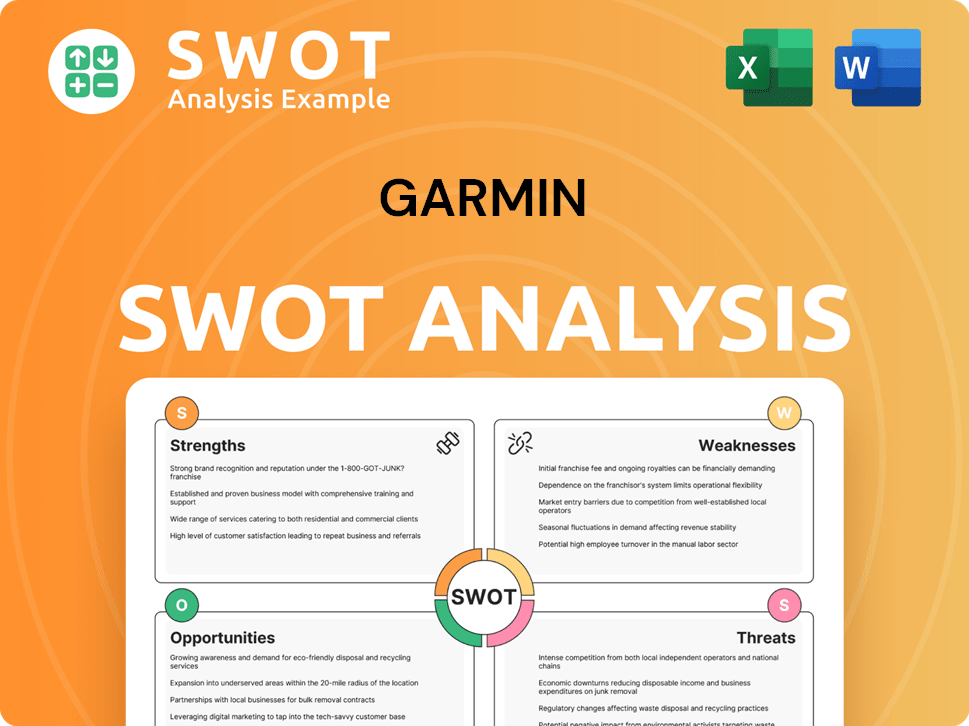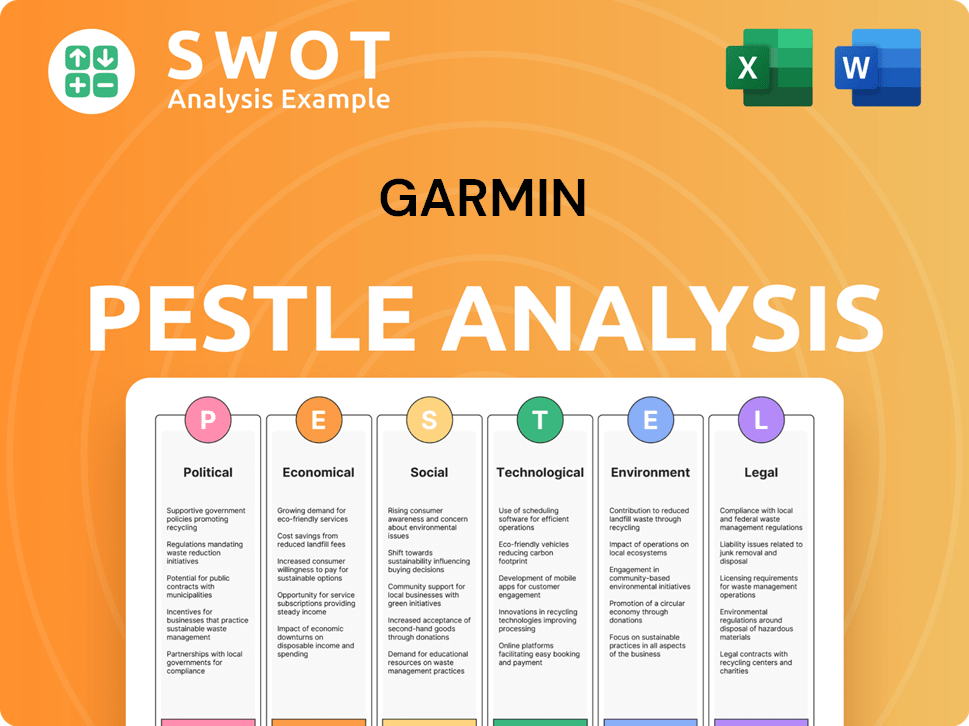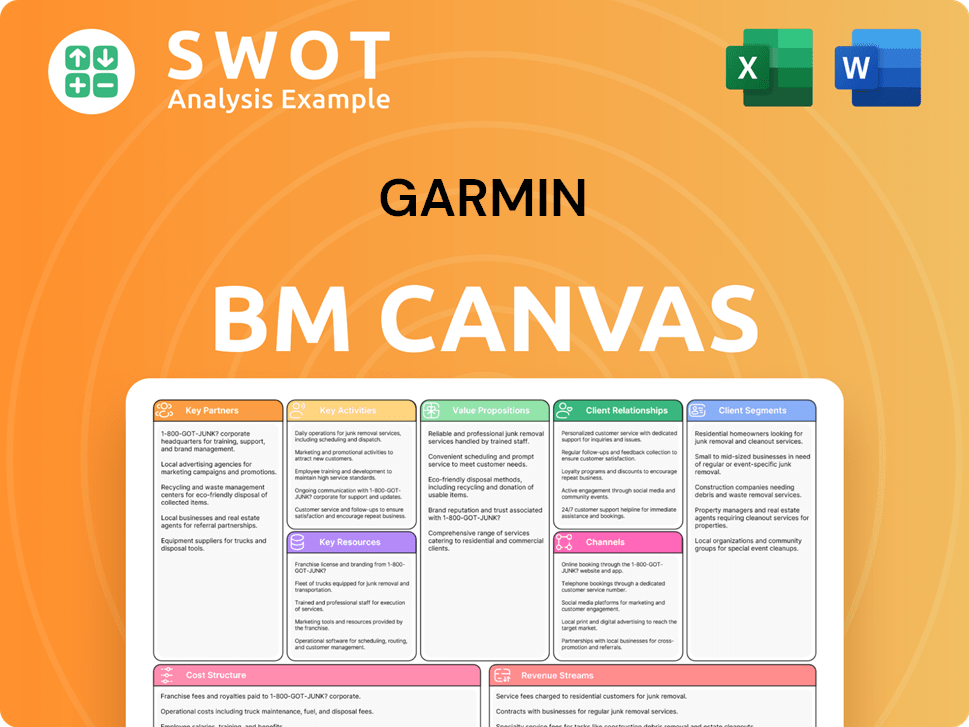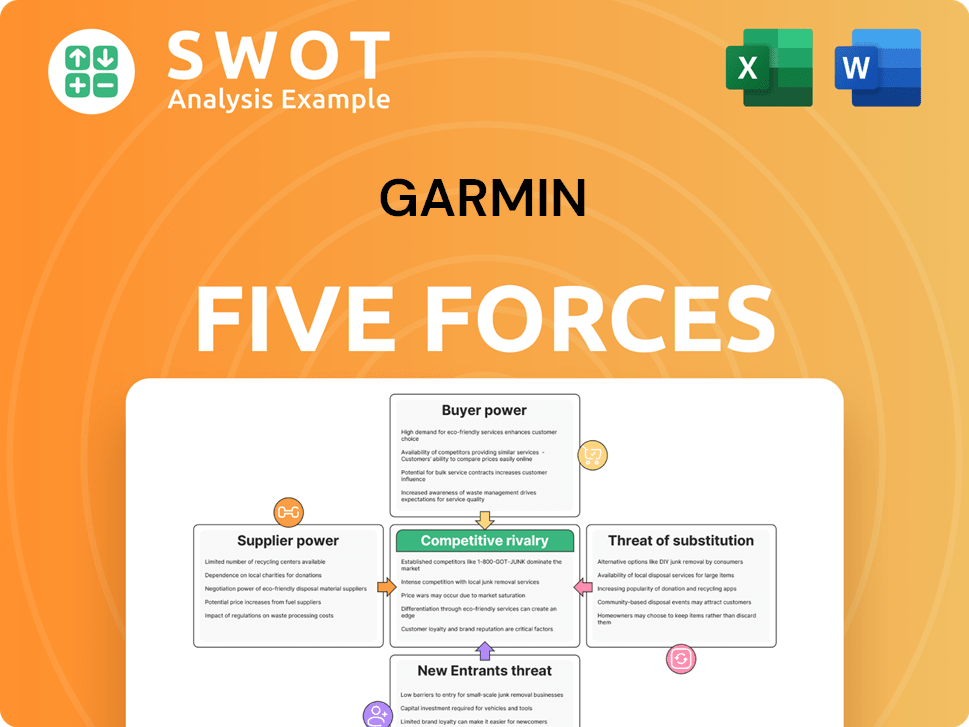Garmin Bundle
Can Garmin Maintain Its Edge in a Crowded Market?
From its inception in 1989, Garmin has navigated the technological seas, transforming from a GPS pioneer to a diversified powerhouse. Today, the company's influence spans across automotive, aviation, fitness, marine, and outdoor recreation sectors, but how does it stand up against its rivals? Understanding the Garmin SWOT Analysis is crucial to understanding its competitive landscape.

The Garmin competitive landscape is constantly shifting, demanding a keen understanding of its Garmin competitors and the broader Garmin industry. This analysis will dissect Garmin's market position, examining its strategies to compete in the GPS device market and the fierce wearable technology competition. We'll explore Garmin's main rivals in fitness trackers, delve into the market share of Garmin in the smartwatch industry, and assess Garmin's competitive advantages in navigation to provide a comprehensive Garmin market analysis.
Where Does Garmin’ Stand in the Current Market?
Garmin holds a strong market position, particularly in specialized segments due to its brand recognition and product offerings. The company demonstrates leadership or a significant presence in key areas such as fitness, outdoor, marine, and aviation. This is a critical aspect of the Garmin competitive landscape.
Garmin's core product lines include smartwatches, fitness trackers, cycling computers, marine chartplotters, aviation navigation systems, and outdoor handheld GPS devices. Geographically, the company operates globally, with a significant presence in North America, Europe, and Asia. Its strategy emphasizes premium, feature-rich products catering to specific activity-oriented niches. An in-depth Garmin market analysis reveals a focus on specialized markets.
Financially, Garmin reported approximately $5.23 billion in total net sales in 2023, reflecting a 3% year-over-year increase. This financial health enables significant investment in research and development, maintaining its competitive edge. The company's diversification strategy has been successful, with growth in fitness, outdoor, marine, and aviation segments, even as the automotive OEM segment faced a decline. This financial performance is a key factor in understanding the Garmin industry.
Garmin maintains a notable market share in the fitness and wearables market. The company's strong presence in the outdoor and marine segments is especially noteworthy. These specialized areas contribute significantly to Garmin's overall market position. This is a critical aspect of the GPS device market.
Garmin operates worldwide, with a significant presence in North America, Europe, and Asia. These key regions are crucial for its distribution and sales. The global reach supports its diverse customer base and product offerings. This is a critical aspect of the wearable technology competition.
Garmin serves a wide array of customer segments, from professional athletes and outdoor enthusiasts to pilots and mariners. It also caters to everyday consumers seeking reliable navigation and health monitoring solutions. This diverse customer base supports its product portfolio. This is a critical aspect of the Garmin competitors.
In 2023, Garmin's total net sales were approximately $5.23 billion, reflecting a 3% increase year-over-year. The company's consistent profitability enables it to invest in research and development. This financial strength supports its competitive advantages. To learn more about Garmin's financial strategies, check out this article on Growth Strategy of Garmin.
Garmin's strong brand recognition and specialized product offerings are key advantages. The company's focus on premium, feature-rich products allows it to compete effectively. Garmin's established reputation and certified products provide a significant barrier to entry in specialized markets like aviation and marine.
- Strong brand recognition in target markets.
- Focus on premium, feature-rich products.
- Significant presence in aviation and marine markets.
- Consistent investment in research and development.
Garmin SWOT Analysis
- Complete SWOT Breakdown
- Fully Customizable
- Editable in Excel & Word
- Professional Formatting
- Investor-Ready Format

Who Are the Main Competitors Challenging Garmin?
The Marketing Strategy of Garmin involves navigating a complex competitive landscape across multiple sectors. Understanding the key players and their strategies is crucial for assessing Garmin's market position and future prospects. This analysis provides insights into the competitive dynamics within the GPS device market, wearable technology competition, and other relevant segments.
Garmin's success hinges on its ability to differentiate itself from competitors through specialized features, robust product offerings, and strong brand recognition. The company's competitive advantages vary across its segments, requiring a nuanced understanding of each market's dynamics. This includes analyzing the market share of Garmin in the smartwatch industry and understanding Garmin's strategies to compete with Samsung and Apple.
Garmin faces a diverse array of competitors across its five primary segments: automotive, aviation, fitness, marine, and outdoor. The competitive landscape is dynamic, with constant innovation and shifting consumer preferences influencing market share across all of Garmin’s segments. A detailed Garmin market analysis reveals the challenges and opportunities in each of these sectors.
In the fitness and wearable technology market, key competitors include Apple, Samsung, and Huawei. These companies offer smartwatches with advanced health tracking features and broad app ecosystems. Garmin differentiates itself by offering specialized devices tailored for serious athletes and outdoor enthusiasts.
Traditional competitors in the outdoor and handheld GPS segment include Magellan and TomTom. Garmin has largely dominated this space due to its comprehensive mapping solutions and robust device offerings. Emerging players might include app-based navigation solutions that leverage smartphone GPS capabilities.
In the marine sector, competitors like Raymarine, Simrad, and Lowrance offer a range of chartplotters, fishfinders, and radar systems. Garmin often competes by integrating advanced sonar technologies, detailed mapping, and user-friendly interfaces.
The aviation market sees Garmin competing with companies like Honeywell and Collins Aerospace. This segment is characterized by high barriers to entry due to stringent regulatory requirements. Garmin's long-standing presence and reputation for quality provide a significant competitive advantage.
In the automotive segment, the rise of built-in navigation systems and smartphone-based navigation apps present challenges. Garmin maintains a presence through OEM partnerships and specialized fleet management solutions. The competitive landscape is dynamic.
Garmin's competitive advantages include specialized devices for athletes and outdoor enthusiasts, superior battery life, ruggedness, and specific activity metrics. Garmin's long-standing presence and reputation for quality in aviation provide a significant competitive advantage. The company's ability to innovate and adapt to changing consumer preferences is also crucial.
Understanding the key competitors and market dynamics is essential for a comprehensive Garmin competitive landscape analysis. This includes evaluating Garmin's main rivals in fitness trackers, the competitive analysis of Garmin's product line, and how Garmin differentiates itself from the competition. The GPS device market and wearable technology competition are constantly evolving, requiring Garmin to continuously innovate and adapt.
- Apple, Samsung, and Huawei: Primary competitors in fitness and wearable technology, offering smartwatches with strong brand recognition and extensive ecosystems.
- Magellan and TomTom: Traditional competitors in the outdoor and handheld GPS segment, although Garmin has a dominant market share.
- Raymarine, Simrad, and Lowrance: Key players in the marine sector, offering chartplotters and related systems.
- Honeywell and Collins Aerospace: Competitors in the aviation market, where Garmin competes in integrated flight decks and avionics.
- Google Maps and Waze: Smartphone-based navigation apps that challenge Garmin in the automotive segment.
Garmin PESTLE Analysis
- Covers All 6 PESTLE Categories
- No Research Needed – Save Hours of Work
- Built by Experts, Trusted by Consultants
- Instant Download, Ready to Use
- 100% Editable, Fully Customizable

What Gives Garmin a Competitive Edge Over Its Rivals?
The competitive advantages of the company, a leader in GPS technology and wearable devices, are multifaceted, stemming from proprietary technologies, strong brand recognition, and specialized expertise across various markets. Its extensive intellectual property portfolio, particularly in GPS and sensor technologies, underpins the precision and reliability of its devices. This is evident in its advanced mapping capabilities and sophisticated biometric sensors found in its fitness wearables. A Brief History of Garmin reveals the company's evolution and strategic focus.
The company's brand equity, built over decades of delivering high-quality and dependable products, fosters significant customer loyalty, especially in aviation and marine segments where reliable navigation equipment is crucial. The company's reputation for ruggedness and accuracy in outdoor and fitness devices also contributes to a dedicated user base. This loyalty is further reinforced by a robust ecosystem of compatible accessories, software platforms, and a strong customer support network.
The company also benefits from economies of scale in manufacturing and a well-established global distribution network, allowing it to efficiently bring products to market. Its vertically integrated approach, from design and development to manufacturing, provides greater control over quality and innovation cycles. Furthermore, the company's talent pool, particularly its engineers and product developers, possesses specialized knowledge in GPS, wireless communication, and sensor integration, enabling the company to consistently innovate and differentiate its offerings.
The company's core strength lies in its proprietary technologies, especially in GPS and sensor integration. This includes advanced mapping, multi-band GPS, and sophisticated biometric sensors. These technologies are crucial for the company's competitive edge in the GPS device market.
The company's brand is synonymous with quality and reliability, fostering strong customer loyalty. This is particularly evident in the aviation and marine sectors. Its reputation for ruggedness and accuracy in outdoor and fitness devices also contributes to a dedicated user base.
The company's vertically integrated approach, from design to manufacturing, provides greater control over quality and innovation cycles. Economies of scale in manufacturing and its global distribution network allow efficient product launches. This efficiency supports its ability to compete effectively in the wearable technology competition.
The company's talent pool, especially its engineers, possesses specialized knowledge in GPS, wireless communication, and sensor integration. This expertise enables continuous innovation, differentiating its offerings. This is critical for the company's strategies to compete with Samsung and other competitors.
The company's competitive advantages are sustained by its technology, brand, and operational efficiencies. These factors allow the company to maintain a strong position in the market. The company's market analysis shows a consistent focus on innovation and customer satisfaction.
- Proprietary Technology: Advanced GPS, sensors, and mapping.
- Brand Reputation: Strong brand equity and customer loyalty.
- Vertical Integration: Control over quality and innovation.
- Specialized Expertise: Skilled engineers and product developers.
Garmin Business Model Canvas
- Complete 9-Block Business Model Canvas
- Effortlessly Communicate Your Business Strategy
- Investor-Ready BMC Format
- 100% Editable and Customizable
- Clear and Structured Layout

What Industry Trends Are Reshaping Garmin’s Competitive Landscape?
The Garmin competitive landscape is significantly influenced by industry trends, including rapid technological advancements and evolving consumer preferences. The increasing integration of smart features and the demand for personalized data insights present both challenges and opportunities for the company. The market analysis reveals that Garmin's ability to adapt to these changes will be crucial for maintaining its market position.
Garmin's risks include the commoditization of basic GPS functionalities and the need to compete with smartphones. Data privacy and aviation safety standards also present ongoing challenges. However, opportunities exist in emerging markets, the aging population, and the growing demand for sustainable products. For a deeper dive into the company's growth strategy, refer to the article on Growth Strategy of Garmin.
Technological advancements are reshaping the Garmin industry, with multi-sensor integration and AI-driven analytics becoming increasingly important. Consumer preferences are shifting towards devices that offer sophisticated software, personalized data, and seamless connectivity. The proliferation of smartphones with built-in navigation systems continues to impact the GPS device market.
Garmin's main rivals in fitness trackers and the broader wearable technology competition include companies that are constantly innovating. The commoditization of basic GPS functionalities poses a threat, requiring a focus on specialized products. Regulatory changes, particularly in data privacy and aviation safety, present ongoing challenges that demand significant investment.
Emerging markets and the aging global population offer significant growth opportunities for Garmin. The increasing demand for sustainable products and eco-friendly manufacturing processes could differentiate Garmin. Advancements in augmented reality (AR) and AI for personalized health and fitness coaching present new avenues for innovation.
Garmin's competitive advantages in navigation and specialized electronics should be leveraged through continued investment in R&D. Strategic partnerships can help expand its ecosystem, while focusing on niche markets can provide a distinct advantage. Rapid innovation and adaptation to changing consumer expectations are crucial for resilience.
Garmin faces challenges in the outdoor watch market and must compete with companies like Apple and Samsung. Garmin's pricing strategy versus competitors and its ability to differentiate itself are critical. Garmin's revenue compared to its competitors and its market share of the smartwatch industry are important metrics.
- Continued investment in R&D is vital to maintain a competitive edge.
- Strategic partnerships can broaden the product ecosystem and market reach.
- Focusing on niche markets allows Garmin to leverage its specialized expertise.
- Adaptability and innovation are key to meeting evolving consumer demands.
Garmin Porter's Five Forces Analysis
- Covers All 5 Competitive Forces in Detail
- Structured for Consultants, Students, and Founders
- 100% Editable in Microsoft Word & Excel
- Instant Digital Download – Use Immediately
- Compatible with Mac & PC – Fully Unlocked

Related Blogs
- What are Mission Vision & Core Values of Garmin Company?
- What is Growth Strategy and Future Prospects of Garmin Company?
- How Does Garmin Company Work?
- What is Sales and Marketing Strategy of Garmin Company?
- What is Brief History of Garmin Company?
- Who Owns Garmin Company?
- What is Customer Demographics and Target Market of Garmin Company?
Disclaimer
All information, articles, and product details provided on this website are for general informational and educational purposes only. We do not claim any ownership over, nor do we intend to infringe upon, any trademarks, copyrights, logos, brand names, or other intellectual property mentioned or depicted on this site. Such intellectual property remains the property of its respective owners, and any references here are made solely for identification or informational purposes, without implying any affiliation, endorsement, or partnership.
We make no representations or warranties, express or implied, regarding the accuracy, completeness, or suitability of any content or products presented. Nothing on this website should be construed as legal, tax, investment, financial, medical, or other professional advice. In addition, no part of this site—including articles or product references—constitutes a solicitation, recommendation, endorsement, advertisement, or offer to buy or sell any securities, franchises, or other financial instruments, particularly in jurisdictions where such activity would be unlawful.
All content is of a general nature and may not address the specific circumstances of any individual or entity. It is not a substitute for professional advice or services. Any actions you take based on the information provided here are strictly at your own risk. You accept full responsibility for any decisions or outcomes arising from your use of this website and agree to release us from any liability in connection with your use of, or reliance upon, the content or products found herein.